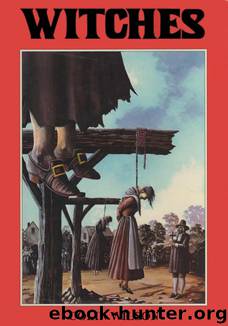Witches by Colin Wilson

Author:Colin Wilson [Wilson, Colin]
Language: eng
Format: epub, mobi
Tags: Body; Mind & Spirit, Magick Studies, Witchcraft
ISBN: 9780517654941
Google: OBaLan0aJaEC
Publisher: Crescent Books
Published: 1981-01-01T13:30:00+00:00
CHAPTER 16
Witchcraft in Germany
In Germany, thousands of people had been executed for witchcraft by the beginning of the seventeenth century, most of them tortured, many burned alive; thousands more would die before the persecutions came to a halt.
In Treves, five women were burned as witches in 1572, but this was only a prelude to the trials that began in 1582. By then, the harvest had been poor for several years, and witches were blamed. (Such troubles often seem to cause witch persecutions; a hundred years later, Massachusetts was having all kinds of political problems when the Salem ‘witch scare’ helped to release the sense of oppression and helplessness.) Between 1587 and 1594, 306 persons were accused of being witches, and they involved another six thousand people in their confessions as accomplices. In his History of Treves Johan Linden, canon of the cathedral, notes: ‘Scarcely any of those who were accused escaped punishment’.
Dietrich Flade, Vice-Governor of Treves and Rector of the university, objected that many of the trials were illegal, and was himself accused as a witch and burned.
Franz Buirmann was a German equivalent of the English ‘witch-finder’ Matthew Hopkins; but there were many like him, and his career has survived only because Hermann Löher, a humanitarian court official who was forced to flee to Holland, wrote about his personal knowledge of Buirmann in a book published many years later. Löher lived at Rheinbach, near Bonn, a quiet village that had little crime. Buirmann, described as a ‘shrewd man of low birth’, had been appointed itinerant judge and witch-hunter by the Archbishop of Cologne; he was able to claim the property of those he condemned as witches, and as a consequence, became affluent. In 1631 and 1636 he paid two visits to Rheinbach and two nearby villages, and burned 150 people out of 300 households. In further persecutions at Siegburg later the same year, Buirmann even had the executioner burned as a witch.
The German witch persecutions occurred mainly in towns that remained Catholic (like Treves). Other such areas were Strasbourg, Breslau, Fulda, Würzburg and Bamberg. Würzburg and Bamberg were ruled by cousins, one of whom burned 900 people, the other 600. In Bamberg, the witch burning began around 1609, under Bishop von Aschhausen, who in thirteen years burned 300 witches. In another series of trials between 1626 and 1630, 400 people were burned. When the Vice-Chancellor tried stopping the trials, he was accused as a witch and executed with his wife and daughter. (The Prince-Archbishop ignored an order from the Emperor ordering their release.) But the Bamberg trials stopped as abruptly as they had started, in 1630, partly because of the invasion of Leipzig by the Swedish King Gustavus, which gave the instigators of the trials other things to think about, partly because of the continued opposition of the Emperor.
In Würzburg in 1629, the Chancellor described in a letter how he had seen many children executed for intercourse with the devil—their ages ranging from three to fifteen. He adds that it
Download
This site does not store any files on its server. We only index and link to content provided by other sites. Please contact the content providers to delete copyright contents if any and email us, we'll remove relevant links or contents immediately.
Wonder by R.J. Palacio(8430)
Mastering Adobe Animate 2023 - Third Edition by Joseph Labrecque(3720)
Unlabel: Selling You Without Selling Out by Marc Ecko(3574)
Ogilvy on Advertising by David Ogilvy(3485)
Hidden Persuasion: 33 psychological influence techniques in advertising by Marc Andrews & Matthijs van Leeuwen & Rick van Baaren(3454)
Drawing Cutting Edge Anatomy by Christopher Hart(3440)
The Pixar Touch by David A. Price(3347)
POP by Steven Heller(3297)
The Code Book by Simon Singh(3057)
The Art of War Visualized by Jessica Hagy(2932)
Slugfest by Reed Tucker(2924)
The Curated Closet by Anuschka Rees(2897)
Rapid Viz: A New Method for the Rapid Visualization of Ideas by Kurt Hanks & Larry Belliston(2815)
Stacked Decks by The Rotenberg Collection(2796)
365 Days of Wonder by R.J. Palacio(2737)
The Wardrobe Wakeup by Lois Joy Johnson(2717)
Keep Going by Austin Kleon(2682)
Tattoo Art by Doralba Picerno(2583)
Tell Me More by Kelly Corrigan(2579)
